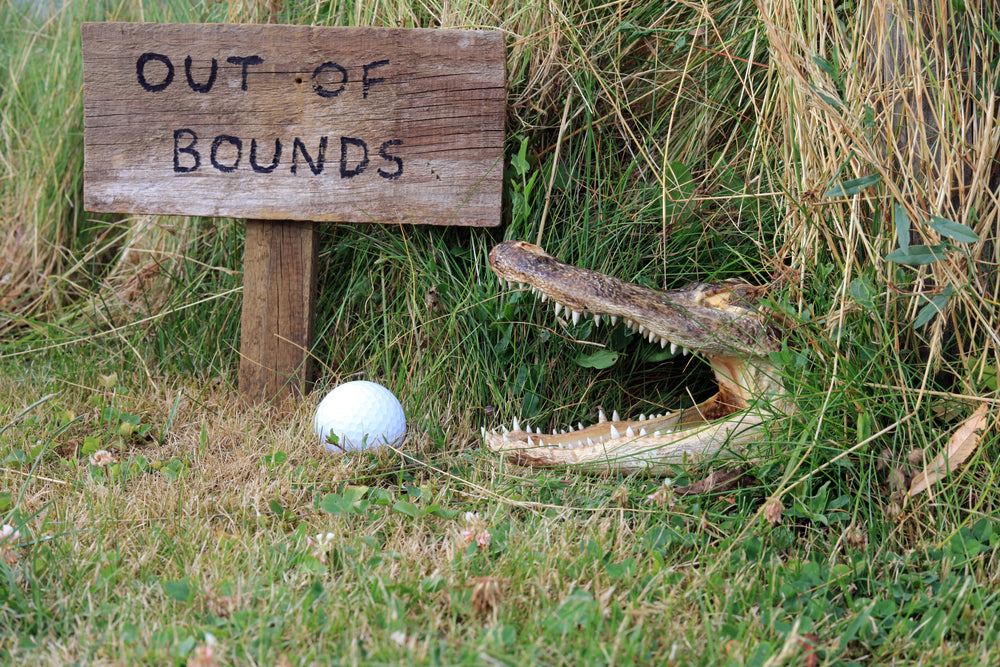Key Takeaways
- Understanding golf course hazards is essential for improving your game.
- Water hazards and bunkers are the most common challenges you'll face.
- Strategic planning and risk assessment can help you navigate hazards effectively.
- Choosing the right clubs is crucial for overcoming different obstacles.
- Adopting a positive mindset can significantly improve your hazard navigation skills.
Article-at-a-Glance
When you're out on the golf course, hazards are unavoidable. But with the right techniques and strategies, you can turn these challenges into opportunities to showcase your skills. In this guide, we'll explore various tips and techniques to help you master golf course hazard navigation.
The Basics of Hazards on a Golf Course
Every golf course is designed with a variety of hazards to challenge players and make the game more exciting. These hazards can include anything from water bodies to sand traps, and even natural obstacles like trees and roughs. Understanding these hazards is the first step in learning how to navigate them successfully.
Types of Golf Course Hazards
There are several types of hazards that you may encounter on a golf course:
- Water Hazards: Lakes, ponds, and streams can make your shots more challenging.
- Bunkers: These sand traps require precise technique to escape effectively.
- Natural Hazards: Trees, bushes, and roughs can obstruct your path to the hole.
Each type of hazard requires a different approach and strategy to navigate successfully.
Pitfalls and Challenges in Hazard Navigation
One of the biggest challenges in hazard navigation is the mental aspect. It’s easy to become intimidated by the presence of a water hazard or a deep bunker. This can lead to poor shot execution and increased scores. Most importantly, overcoming these mental hurdles is key to improving your game. For more insights on mastering these challenges, check out this guide to golf course hazards.
Besides that, physical challenges like uneven terrain or strong winds can also affect your ability to navigate hazards effectively. Therefore, it's crucial to prepare both mentally and physically before tackling any hazard on the course.
Proactive Risk Assessment and Planning
Effective hazard navigation starts long before you even step onto the course. Proactive risk assessment and planning can help you avoid potential pitfalls and optimize your performance.
Evaluating the Course Layout
Before you begin your round, take some time to evaluate the course layout. Familiarize yourself with the location of various hazards and plan your shots accordingly. This will help you avoid unnecessary risks and improve your overall score.
Choosing the Right Clubs
Choosing the right clubs is critical when it comes to navigating hazards. Different clubs offer varying levels of control and distance, so it's essential to select the ones that best suit the specific challenge you're facing.
For example, a higher-lofted club may be more effective for escaping a bunker, while a low-lofted club can help you clear a water hazard with ease. Always assess the situation and choose your clubs wisely. For more insights, check out these golf fade tips and techniques.
Strategic Positioning to Avoid Hazards
Strategic positioning is another key aspect of hazard navigation. By positioning yourself correctly on the course, you can minimize the impact of hazards and increase your chances of success. Aim to land your shots in safe areas that provide clear paths to the hole, avoiding hazards whenever possible.
Effective Techniques for Overcoming Specific Hazards
Navigating specific hazards on a golf course requires a blend of technique, strategy, and mental fortitude. By focusing on these elements, you can effectively tackle any obstacle that comes your way. For more insights, explore the top 10 misunderstood golf rules and how to get them right.
Firstly, understanding the nature of each hazard is crucial. Different hazards present unique challenges and require tailored approaches. This section will delve into strategies for dealing with common golf course hazards.
Example: Consider a situation where you're faced with a water hazard. Instead of attempting a risky shot over the water, it might be wiser to aim for a safer area and play an extra stroke. This strategic decision can save you from penalties and keep your score in check. For more insights, check out the top 10 misunderstood golf rules and how to get them right.
Being prepared with the right techniques and mindset can transform these daunting obstacles into manageable challenges.
Strategies for Water Hazards
Water hazards can be intimidating, but with the right strategy, you can navigate them successfully. Start by assessing the distance and determining if you can safely clear the hazard. If the shot is too risky, consider laying up and taking an extra stroke to avoid penalties. For more guidance, check out these misunderstood golf rules that can impact your game.
Additionally, using a club with enough loft can help you achieve the necessary height to clear the water. Always factor in wind conditions, as they can significantly affect the ball's trajectory.
How to Escape Bunkers Successfully
Escaping bunkers requires precision and technique. When in a bunker, focus on hitting the sand just behind the ball to lift it out. Use an open clubface and a firm grip to maintain control and prevent the club from digging too deeply into the sand. For more on improving your game, explore these consistent swing mechanics techniques.
Practicing bunker shots regularly can enhance your confidence and improve your ability to escape these sandy traps efficiently. Remember, a smooth swing and steady follow-through are key to a successful bunker shot.
Dealing with Natural Hazards like Trees and Rough
Natural hazards, such as trees and rough, can obstruct your path and complicate your shots. When faced with trees, look for gaps or clear lines of play that allow you to bypass the obstacle. Sometimes, a low punch shot can help you navigate under tree branches. For more tips, explore these golf fade techniques to improve your shot.
In rough areas, focus on maintaining a strong grip and a controlled swing. The thicker grass can slow down your club, so a firmer grip ensures that you maintain control throughout the swing. For more tips on overcoming obstacles, check out this guide on golf course hazards.
“Your Guide To Golf Course Hazards …” from wholeinonebar.com and used with no modifications.
Mental and Physical Preparation for Hazard Navigation
Being mentally and physically prepared is essential for effective hazard navigation. Golf is as much a mental game as it is a physical one, and developing the right mindset can significantly impact your performance.
Physical preparation involves regular practice and conditioning to ensure that you're ready to tackle any obstacle. By focusing on both mental and physical aspects, you can enhance your ability to navigate hazards successfully. For additional strategies, consider these golf fade tips and techniques to improve your shot.
The Importance of a Positive Mindset
A positive mindset is crucial when facing hazards. Approach each challenge with confidence and focus on executing your shot to the best of your ability. Avoid dwelling on past mistakes, and instead, learn from them to improve future performance.
Visualization Techniques for Success
Visualization is a powerful tool in golf. By picturing a successful shot in your mind, you can boost your confidence and improve your chances of executing it well. Before taking your shot, visualize the ball's trajectory and landing spot.
- Picture the swing and follow-through.
- Imagine the ball soaring over the hazard.
- Visualize a smooth landing on the green.
Practicing visualization regularly can help you develop a more consistent and confident approach to hazard navigation.
Practicing Swing Adjustments for Hazard Navigation
Practicing swing adjustments is vital for navigating hazards effectively. Different hazards require specific swing modifications to achieve the desired outcome.
- For bunkers, practice hitting the sand behind the ball.
- For water hazards, focus on achieving height and distance.
- For natural hazards, work on controlled swings and accurate shot placement.
By dedicating time to practice these adjustments, you can enhance your ability to handle various hazards on the course.
Using Technology to Enhance Hazard Management
Technology plays a significant role in modern golf, offering tools and resources to improve hazard management. From swing analysis to course mapping, technology can provide valuable insights to enhance your game.
Utilizing technology effectively can give you a competitive edge and help you navigate hazards with greater precision and confidence. For instance, mastering golf fade techniques can significantly enhance your game.
Benefits of Golf Swing Motion Capture Systems
Golf swing motion capture systems offer golfers a detailed analysis of their swing mechanics. By capturing every movement, these systems provide insights into swing speed, angle, and trajectory. This information is invaluable for identifying areas that need improvement and for developing a more consistent swing.
Moreover, these systems allow golfers to compare their swings with those of professional players. This comparison can highlight specific differences and provide guidance on how to make adjustments. By utilizing motion capture systems, golfers can enhance their understanding of their swing mechanics and work towards achieving their desired performance on the course.
Utilizing Simulation for Hazard Navigation
Simulation technology is a game-changer when it comes to hazard navigation. Golf simulators allow players to practice on virtual courses that replicate real-world conditions. This enables golfers to experience different hazards and develop strategies for overcoming them without the pressure of an actual game.
By practicing in a simulated environment, golfers can experiment with various shot techniques and club selections. This experimentation helps build confidence and prepares golfers for similar situations on the actual course. Simulators also provide immediate feedback, allowing players to make real-time adjustments and refine their approach to hazard navigation.
Conclusion: Master Your Hazard Navigation
Mastering hazard navigation is a crucial skill for any golfer looking to improve their game. By understanding the different types of hazards, adopting effective strategies, and utilizing technology, you can enhance your ability to navigate obstacles on the course.
Remember, golf is a game of both physical skill and mental fortitude. By maintaining a positive mindset and practicing regularly, you can develop the confidence and consistency needed to tackle any hazard that comes your way. Embrace these techniques and watch your game reach new heights.
Frequently Asked Questions
Golfers often have questions about how to effectively navigate hazards. Here are some of the most common inquiries and their answers:
What are the most common golf course hazards?
Golf courses feature a variety of hazards designed to challenge players. The most common include sand traps, water hazards, and rough terrain. To navigate these effectively, players can benefit from consistent swing mechanics.
- Water hazards, such as lakes and ponds
- Bunkers or sand traps
- Natural hazards, like trees and roughs
Understanding these hazards and how to approach them is key to improving your performance on the course.
How can I improve my skills in avoiding water hazards?
Improving your skills in avoiding water hazards involves strategic planning and practice. Focus on assessing the distance and determining the safest route to avoid the hazard. Use clubs that provide enough loft to clear the water and always consider wind conditions before taking your shot.
What mental strategies can I use when facing tough hazards?
Facing tough hazards requires mental resilience and a positive mindset. Visualization is a powerful tool that can help you mentally prepare for challenging shots.
Example: Before taking your shot, close your eyes and visualize the ball's path over the hazard and landing safely on the green. This mental imagery can boost your confidence and improve your shot execution. For more tips, explore our guide to golf course hazards.
Additionally, focus on staying calm and composed, even if you encounter difficulties. Learning from past experiences and maintaining a growth mindset will help you improve over time.
Are there specific clubs that help in getting out of bunkers?
Yes, specific clubs are designed to help golfers escape bunkers effectively. Wedges, particularly sand wedges, are ideal for bunker shots due to their loft and bounce. The loft helps lift the ball out of the sand, while the bounce prevents the club from digging too deeply.
When using a sand wedge, focus on hitting the sand just behind the ball and maintaining a smooth swing. Practice regularly to build confidence and consistency in your bunker shots.
How does technology aid in better navigating course hazards?
Technology plays a significant role in enhancing hazard navigation. Golf swing motion capture systems provide detailed insights into swing mechanics, helping golfers identify areas for improvement. Simulators offer virtual practice environments where players can experiment with different strategies and receive immediate feedback.
Additionally, GPS and course mapping tools help golfers assess the layout of the course and identify potential hazards. By incorporating technology into your practice routine, you can develop a deeper understanding of your game and improve your ability to navigate hazards successfully.
By embracing these tools and techniques, you'll be well-equipped to tackle any obstacle on the golf course with confidence and precision.
Golf courses are designed with a variety of hazards that can challenge even the most seasoned players. Understanding how to navigate these obstacles is crucial for improving your game. For an in-depth guide on mastering these challenges, check out Navigating Golf Course Hazards by Gears Sports.


